Geoscience Reference
In-Depth Information
6.6 RED SEA SEDIMENTS
While benthic sediments at ocean bottoms provide an indication of past glaciation,
such sediments in constricted areas such as the Red Sea are distorted by the
changing rate of flow into and out of the Red Sea as the ocean level changes.
However, this effect can be exploited to estimate the past variability of sea level
using dynamic models for the Red Sea and its interchange with the open ocean.
An estimate of past sea level variability was based on the fact that the Red
Sea is extremely sensitive to sea level change, as a consequence of the narrow
(18 km) and shallow (137m) character of its only connection with the open ocean
(Siddall et al., 2003). During periods when sea level is lowered, the rate of
exchange transport of water through the strait is reduced. This leads to an
increased residence time of water within the Red Sea, enhancing the effect of the
high rate of evaporation on the properties of residual water in the Red Sea. The
basin thus amplifies the signals of sea level change, which are recorded in
d
18
O
values of foraminifera in Red Sea sediment cores. This amplification was
previously used to calculate sea level low stands at times of maximum glaciation
during the past 500
kybp
(Rohling et al., 1998). To unlock the potential of Red
Sea data for the development of continuous sea level records (rather than only
low stands) Siddall et al. (2003) combined a model for flow exchange in the strait
with a model of the Red Sea basin. They calculated salinity and
d
18
O values for
calcite in equilibrium with ambient water. Changes in modeled salinity and
d
18
O
values were dominated by changes in sea level. The simulated variation of
d
18
O
values with sea level change were used to translate
d
18
O values records from
sediment cores into records of past sea level change.
Strictly speaking, these sea level reconstructions pertain to the level at B
ab el
Mandab (Yemen), which may deviate somewhat from truly global changes owing
to uplift and isostatic effects. Uplift of the strait was estimated and corrected for.
Isostatic effects were believed to be negligible. It was therefore concluded that
Figure 6.10. Smoothed data on sea level based on Red Sea sediments and coral terrace data
(Siddall et al., 2003).

Search WWH ::

Custom Search